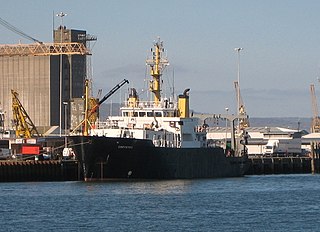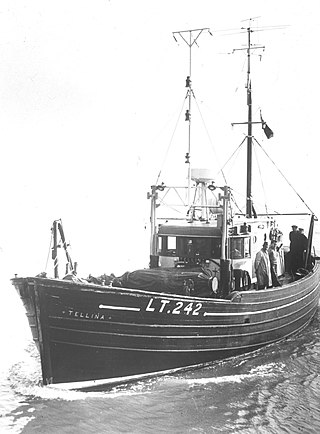The Centre for Environment, Fisheries and Aquaculture Science (Cefas) is an executive agency of the United Kingdom government Department for Environment, Food and Rural Affairs (Defra). It carries out a wide range of research, advisory, consultancy, monitoring and training activities for a large number of customers around the world.

HMS Bangor was a Bangor-class minesweeper of the Royal Navy that served during the Second World War. She was built at the Harland and Wolff shipyard in Govan, Scotland. Bangor was the lead vessel of her class and one of the diesel-engined versions. She was ordered on 12 July 1939, laid down on 19 September 1939, launched on 23 May 1940, and commissioned on 7 November 1940.

The Royal Naval Patrol Service (RNPS) was a branch of the Royal Navy active during both the First and Second World Wars. The RNPS operated many small auxiliary vessels such as naval trawlers for anti-submarine and minesweeping operations to protect coastal Britain and convoys.

A danlayer was a type of vessel assigned to minesweeping flotillas during and immediately after World War II. They were usually small trawlers, fitted for the purpose of laying dans. A dan is a marker buoy which consists of a long pole moored to the seabed and fitted to float vertically, usually with a coded flag at the top.

HMS Britomart was a Halcyon-class minesweeper of the Royal Navy. She served during the Second World War and was sunk in 1944 in a friendly fire incident. The actor Robert Newton served aboard her until 1943.

HMS Sir Galahad was a trawler built for the British Royal Navy in 1941. Post war it was sold into civilian service and was wrecked in 1957 after running aground off the Isle of Mull.

RV Corystes is an ocean-going, research vessel operating around Northern Ireland. She is equipped with specialist fishing gear and acoustic techniques for surveys of fish stocks.

RV Cefas Endeavour is an ocean-going fisheries research vessel based at the port of Lowestoft and owned by the Centre for Environment, Fisheries and Aquaculture Science (Cefas).

HM Trawler Alvis was a British trawler that was taken up from trade and used by the Royal Navy during the Second World War. She was returned to the fishing industry at the end of hostilities in 1945.

US FWS Albatross III was a fisheries research ship in commission in the United States Fish and Wildlife Service from 1948 to 1959. Prior to her Fish and Wildlife Service career, she operated as the commercial fishing trawler SS Harvard and briefly saw service during World War II as the United States Coast Guard patrol vessel USCGC Bellefonte (WYP-373), in commission from April to August 1944. She was wrecked in Cuba as Nyleve in 1969.

RV Cirolana was a fisheries research vessel used by the Centre for Environment, Fisheries and Aquaculture Science and originally built for the Ministry of Agriculture, Fisheries and Food. She was initially intended to replace the RV Ernest Holt operating in arctic waters around Bear Island (Norway) and Iceland, but following the Cod Wars spent most of her working life conducting fisheries surveys in the North Sea, Irish Sea and English Channel. For the first part of her career RV Cirolana was based in the fishing port of Grimsby, but after bridge and channel dredging work improved the depth, it was deemed acceptable to bring her to Lowestoft.

RV Huxley was the first research vessel used by the Marine Biological Association of the United Kingdom explicitly for fisheries research and is regarded as the first vessel yielding data for the Ministry of Agriculture, Fisheries and Food - Directorate of Fisheries, now known as the Centre for Environment, Fisheries and Aquaculture Science (Cefas).

RV Ernest Holt (GY591) was a fisheries research vessel that was operated by the Ministry of Agriculture, Fisheries and Food - Directorate of Fisheries, now known as the Centre for Environment, Fisheries and Aquaculture Science (Cefas).

RV George Bligh (LO309) was a fisheries research vessel that was operated by the Directorate of Fisheries, now known as the Centre for Environment, Fisheries and Aquaculture Science (Cefas).

RV Corella (LT767) was a fisheries research vessel that was operated by the Ministry of Agriculture, Fisheries and Food - Directorate of Fisheries, now known as the Centre for Environment, Fisheries and Aquaculture Science (Cefas) between 1967 and 1983.

RV Clione (LT421) was a fisheries research vessel that was operated by the Ministry of Agriculture, Fisheries and Food - Directorate of Fisheries, now known as the Centre for Environment, Fisheries and Aquaculture Science (Cefas) between 1961 and 1988.

RV Platessa (LT205) was a fisheries research vessel that was operated by the Ministry of Agriculture, Fisheries and Food - Directorate of Fisheries, now known as the Centre for Environment, Fisheries and Aquaculture Science (Cefas) between 1946 and 1967.

SS Joseph & Sarah Miles (LO175) was a ‘mission ship’, constructed for the Royal National Mission to Deep Sea Fishermen and operated from 1902 until 1930. She acted as a hospital ship during the Dogger Bank incident on the night of 21/22 October 1904, when the Russian Baltic Fleet mistook a British trawler fleet for the Imperial Japanese Navy and fired on them in the North Sea.

RV Tellina (LT242) was a fisheries research vessel that was operated by the Ministry of Agriculture, Fisheries and Food - Directorate of Fisheries, now known as the Centre for Environment, Fisheries and Aquaculture Science (Cefas) between 1960 and 1981.
The SY Hildegarde and the SY Hiawatha were steam yachts chartered by the Ministry of Agriculture, Fisheries and Food - Directorate of Fisheries, now known as the Centre for Environment, Fisheries and Aquaculture Science (Cefas) between 1912 and 1914 to carry out fishery investigations.

















